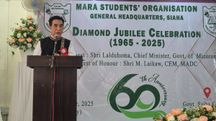This book traces Hitler’s shadow across Israel, Palestine, and beyond
Aabhas Maldahiyar’s book explores the deep-rooted history of Israel and Palestine, questioning Hitler’s role in the conflict. It offers readers a vivid and detailed account of the region’s complex past and present.

"As the calendar turned to August, the clouds of war darkened over Iran. On the fateful day of 25 June, British and Soviet forces swept into the Persian capital...", one of the darkest extracts in the book in question.
Aabhas Maldahiyar’s exposé of Hitler does not begin with the man himself. Instead, it opens with a textured portrayal of Israel - a land, as he writes, that “carries the weight of millennia.” Before walking the reader into the infamous legacy of Adolf Hitler, the dictator whose name refuses to fade from scrutiny, Maldahiyar sets the stage with a brief history of where and how it all began.
Did you even know that "THE" Adolf Hitler had a fair share of impact on the Middle East, on Israel, Palestine, and beyond?
The question that hangs in the air is unsettling: Was Hitler, in fact, the ‘messiah’ of the Palestinian cause? This book confronts that very question — and promises answers within its pages.
"Its soil holds secrets that predate the creeds that now vie for it. It is not a place of mere boundaries but a canvas where civilizations have painted their stories across time,” an extract reads.
Israel, Palestine, Hamas, Jerusalem - names that echo in today’s conversations, shaping and reshaping geopolitics. Names that, as Maldahiyar shows, are far more than markers on a map.
His book is an eye-opener, especially for those fascinated by wartime intrigue and the politics of the Middle East, or by Hitler’s “notorious” hatred towards the Jews. While he remains remembered as a dictator who destroyed countless lives and families, here he is examined against a backdrop many rarely connect him to.
The book is also a gateway to lesser-heard communities and their place in history. A Pandora’s box, it reveals how the past spills into the present, making sense of the Israel and Palestine of today. Canaanites, Assyrians, the Byzantine Empire, Umar’s pact - names many of us may never have encountered, yet each of them holds threads that weave into the current scenario.
Timing, too, is striking. The book’s release coincides with a moment when conflict in the region is at its peak. A resonance that mirrors Maldahiyar’s own words: "In the shadow of the Bar Kokhba revolt, the Land of Israel wept. Judea, once the heart of a vibrant Jewish nation, lay ravaged, its spirit hollowed by the sword and flame."
What stands out is not just the subject but the detail. Maldahiyar pulls into the light what history often lets slip into shadow — how Arab Jihadis played a role, how the Muslim connect has long been a crucial, if uneasy, thread binding communities together.
His strength lies in bluntness. He lays bare revelations and trajectories without softening the edges. "In the vast spread of history, where the threads of faith, culture, and power intertwine, the relationship between Muslims and non-Muslims has been as complex as the patterns in an ornate Persian rug," he writes, a line that encapsulates his unapologetic approach.
Books like these, in their essence, expose how much of the past still lies in a vacuum, waiting to be filled.
And above all, Maldahiyar’s text is not just history - it is imagery. His words build scenes so vivid that imagination leaps from the page. A dictator long gone is suddenly alive before the eyes: "Under a darkened sky laden with intrigue, a curious silence draped over the room as Hitler steeled himself, now determined to avoid further upsetting his guest with jarring words."
The book, however, leaves a lingering feeling : one that echoes in every person’s life: Hitler will never really die. He lives on, in memory and in time.
Copyright©2025 Living Media India Limited. For reprint rights: Syndications Today









